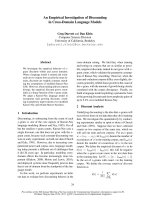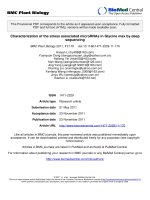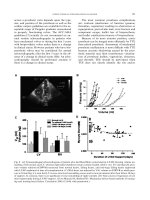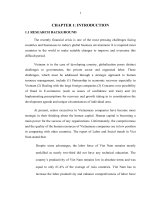Investigation of the role of microRNAs in spinocerebellar ataxia type 3
Bạn đang xem bản rút gọn của tài liệu. Xem và tải ngay bản đầy đủ của tài liệu tại đây (3.74 MB, 139 trang )
Investigation of the role of microRNAs in
Spinocerebellar Ataxia type 3
Dissertation
zur
Erlangung des Doktorgrades (Dr. rer. nat.)
der
Mathematisch-Naturwissenschaftlichen Fakultät
der
Rheinischen Friedrich-Wilhelms-Universität Bonn
vorgelegt von
Rohit Nalavade
aus
Pune, Indien
Bonn, 2015
Angefertigt mit Genehmigung der Mathematisch-Naturwissenschaftlichen Fakultät der
Rheinischen Friedrich-Wilhelms-Universität Bonn
1. Gutachter: PD Dr. Bernd Evert
2. Gutachter: Prof. Dr. Jörg Höhfeld
Tag der Promotion: 20.10.2015
Erscheinungsjahr: 2015
ii
Declaration
I hereby confirm that this dissertation is my own work. It was written independently
without the help of aid unless stated otherwise. Any concepts, data taken from other
sources have been indicated as such. This work has never before been submitted to any
University. I have not applied for a Doctoral procedure before.
An Eides statt versichere ich, dass die vorgelegte Arbeit - abgesehen von den
ausdrücklich bezeichneten Hilfsmitteln - persönlich, selbständig und ohne Benutzung
anderer als der angegebenen Hilfsmittel angefertigt wurde, die aus anderen Quellen
direkt oder indirekt übernommenen Daten und Konzepte unter Angabe der Quelle
kenntlich gemacht sind, die vorgelegte Arbeit oder ähnliche Arbeiten nicht bereits
anderweitig als Dissertation eingereicht worden ist bzw. sind, kein früherer
Promotionsversuch unternommen worden ist, für die inhaltlich-materielle Erstellung
der vorgelegten Arbeit keine fremde Hilfe, insbesondere keine entgeltliche Hilfe von
Vermittlungs- bzw. Beratungsdiensten (Promotionsberater oder andere Personen) in
Anspruch genommen wurde sowie keinerlei Dritte vom Doktoranden unmittelbar oder
mittelbar geldwerte Leistungen für Tätigkeiten erhalten haben, die im Zusammenhang
mit dem Inhalt der vorgelegten Arbeit stehen.
Ort, Datum
Unterschrift
iii
Acknowledgements
This thesis would not have been possible without the support and help of several
people. First and foremost I want to thank my two supervisors PD Dr. Bernd Evert and
Dr. Sybille Krauss for giving me the opportunity to work in their laboratories. It was
great working with both of them and I really learnt a lot about science and also outside
science from them. Both always had time for discussions regarding experiments and
advice on the way forward. They trusted me and were always patient with me. I would
like to thank Prof. Höhfeld for consenting to be my second referee and Prof. Haas and
PD Dr. Eichert for agreeing to be part of my thesis committee. Also, I would like to
thank Prof. Nicotera for creating an ideal research environment with great
infrastructure at DZNE Bonn.
I would like to thank my lab mates for their constant support, help and for making our
lab such a fun place to work. Thanks to Stephanie, who from my first day in the lab
has always helped me and taught me several techniques. A special thanks to Frank for
teaching me mouse related techniques and along with Nadine and Judith for the
discussions and tips during progress reports. Separate thanks to Nadine for ferrying
me back to the lab after our journal clubs. Also, I would like to thank our collaborators
in the Institute of Reconstructive Neurobiology, especially Dr. Michael Peitz and
Johannes Jungverdorben for providing me material for experiments and Dr. Stefan
Bonn at DZNE, Göttingen for conducting the gene and miRNA expression profiles. I
also worked on occasions closely with other labs and facilities in DZNE and hence
thanks to members of the work groups Jackson, Tamguney, Fuhrmann, Bano, Fava
who helped me with the use of equipment in their labs. I would like to thank Clemens,
Melvin and Devon for their help with analysis of profiling data, Kevin for help with
the microscope, Julia for her guidance with mouse related work and Christoph for his
help with the microscopy images. I really appreciate the help provided by Nancy with
administrative issues and the IT Dept. for IT support. I would also like to thank Dr.
Peter Breuer and other members of the Neurobiology workgroup in the University
clinic Bonn for their help. I would like to thank my parents who constantly supported
me although I was half a globe away from them. Finally I would like to thank Tulika
for always being there for me. Being a biologist herself, she was able to understand the
ups and downs of lab life and was always at hand to help me through difficult times.
iv
Summary
Spinocerebellar Ataxia Type 3 (SCA3) is an inherited, neurodegenerative disorder
belonging to the group of polyglutamine repeat disorders. It is caused by CAG repeat
expansions in the ATXN3 gene leading to expanded polyglutamine repeats in the
ATXN3 protein. The expanded ATXN3 protein forms intranuclear inclusions in
neuronal cells ultimately leading to neuronal death. MicroRNAs are endogenously
produced, small, non-coding RNAs that play a role in post-transcriptional regulation of
gene expression. MicroRNA mediated regulation of gene expression is associated with
several processes such as the development of organisms, maintenance of homeostasis
as well as with several human disorders such as cancer and neurodegenerative
diseases.
The present study demonstrates the ability of specific microRNAs to target the
expression of the proteins ATXN3, MID1 and DNAJB1 which play important roles in
the pathogenic mechanisms in SCA3. The microRNAs hsa-miR-32 and hsa-miR-181c
were found to target and reduce ATXN3 expression, while hsa-miR-216a-5p, hsamiR-374a-5p, hsa-miR-542a-3p target and reduce the expression of MID1. Profiling of
gene and microRNA expression in iPSC-derived neurons from SCA3 patients and
controls revealed that in SCA3 neurons, hsa-miR-370 and hsa-miR-543 that target the
expression of the neuroprotective DNAJB1 chaperone are upregulated, while the target
DNAJB1 mRNA and protein are downregulated. Similarly, DNAJB1 mRNA level was
found to be downregulated in a transgenic SCA3 mouse model suggesting that the
miRNA mediated reduction in the neuroprotective DNAJB1 might contribute to the
pathogenesis observed in SCA3.
These results demonstrate the two sided role of microRNAs in the pathogenesis of
SCA3 by targeting the expression of neurotoxic proteins such as ATXN3, MID1 as
well as neuroprotective proteins such as DNAJB1. The findings of this study might
contribute towards miRNA based therapeutic strategies such as enhancing miRNA
targeting of neurotoxic proteins and preventing miRNA targeting of neuroprotective
proteins.
v
Abbreviations
3’ UTR
3’ untranslated region
5’UTR
5’ untranslated region
ALS
amyotrophic lateral sclerosis
AR
androgen receptor
ATP
adenosine triphosphate
ATXN1
ataxin 1 protein
ATXN3
ataxin 3 gene
ATXN3
ataxin 3 protein
C.elegans
Caenorhabditis elegans
CBP
CREB-binding protein
CMV promoter
cytomegalovirus promoter
DM1
myotonic dystrophy type 1
DMEM
Dulbecco’s modified Eagle medium
DMSO
dimethyl sulfoxide
DNA
deoxyribonucleic acid
DNAJB1
DnaJ (Hsp40) homolog, subfamily B, member 1
Drosophila
Drosophila melanogaster
E.coli
Escherichia coli
eIF4B
eukaryotic translation initiation factor 4B
EYA
eyes absent protein
FBS
fetal bovine serum
FDR
false discovery rate
FMR1
fragile X mental retardation 1
FXTAS
fragile X-associated tremor/ataxia syndrome
GO
gene ontology
HD
huntington’s disease
HRP
horse radish peroxidase
hsa-miRNA
homo sapiens-miRNA
HSP
heat shock protein
vi
HTT
huntingtin gene
IB
immunoblotting
IF
immunofluorescence
iPSC
induced pluripotent stem cell
kDa
kilo Dalton
LB
lysogeny broth
LSM
laser scanning microscopy
Lys
lysine
MID1
midline 1
miRISC
microRNA associated RNA induced silencing complex
miRNA
microRNA
MJD
Machado Joseph Disease
mRNA
messenger RNA
mTOR
mechanistic target of rapamycin
NI
intranuclear inclusions
nt
nucleotides
PCR
polymerase chain reaction
PFA
paraformaldehyde
PolyQ diseases
polyglutamine diseases
PP2A
protein phosphatase 2
pre-miRNA
precursor miRNA
pri-miRNA
primary miRNA
PVDF
polyvinylidene fluoride
REST
RE1 silencing transcription factor
RNA
ribonucleic acid
RNA-seq
RNA sequencing
RNAi
RNA interference
S6K
ribosomal protein S6 kinase
SCA1
spinocerebellar ataxia type 1
SCA3
spinocerebellar ataxia type 3
SDS PAGE
sodium dodecyl sulfate polyacrylamide electrophoresis
SOD1
superoxide dismutase 1, soluble
TBP
TATA-binding protein
vii
UIM
ubiquitin interacting motif
V
volt
WC match
Watson-Crick match
YAC
yeast artificial chromosome
μG
microgram
μL
microliter
viii
Table of Contents
Declaration……….…………………………………………………………...........
iii
Acknowledgements………………………………………………………………...
iv
Summary…………………………………………………………….……………..
v
List of Abbreviations………………………………………………………………
vi
Chapter 1 Introduction
1.1 Trinucleotide repeat disorders………………………………………………….
1
1.2 Polyglutamine repeat diseases……………………………………………….....
1
1.3 Spinocerebellar Ataxia type 3 (SCA3)…………………………………………
4
1.4 ATXN3 gene…………………………………………………………………….
5
1.5 ATXN3 protein…………………………………………………………………
6
1.6 DNAJB1………………………………………………………………………...
8
1.7 DNAJB1 in polyglutamine diseases……………………………………..……...
9
1.8 MID1…………………………………………………………………….……… 10
1.9 MicroRNAs……………………………………………………………………..
12
1.10 MicroRNAs in neurodegenerative diseases…………………………………… 14
Aims of the thesis………………………………………………...…….…………..
16
Chapter 2 Materials and Methods
Section 2.1 Materials
2.1.1 List of consumables……………………………………………………….…..
17
2.1.2 List Of Devices……………………………………………………………….
17
2.1.3 List of chemicals……………………………………………………………… 18
2.1.4 Kits used………………………………………………………………………
20
2.1.5 Buffer recipes……………………………………………………………….… 20
2.1.6 Primers………………………………………………………………………... 23
2.1.7 miRNA mimics/siRNAs………………………………………………………
25
2.1.8 Antibodies………………………………………………………………….…. 25
2.1.9 Cell lines………………………………………………………………………
26
2.1.10 Cell and bacterial culture media……………………………………………..
26
ix
Section 2.2 Methods
2.2.1 Prediction of miRNA target sites………………………………...…………… 27
2.2.2 Molecular cloning………………………………………………..……………
28
2.2.3 Cell culture methods………………………………………………..…………
34
2.2.4 Molecular biology methods…………………………………………..……….
39
2.2.5 Microscopy and image analysis………………………………………..……... 44
2.2.6 Mouse hindbrain isolation………………………………………………..…..
44
2.2.7 Gene and miRNA expression profiling and analysis………….……………… 45
2.2.8 Software used……………………………………………………….………… 46
Chapter 3 Results
3.1 miRNA targeting of ATXN3
3.1.1 In silico prediction of miRNAs targeting the 3’UTR of ATXN3
mRNA……………………………………………………………………………..... 48
3.1.2 Validation of the ability of the selected miRNAs to bind at specific sites on
the 3’UTR of ATXN3 mRNA………………………………………………………
50
3.1.3 Analysis of the miRNAs’ effect on endogenous ATXN3 mRNA and protein
levels in human cell lines…………………………………………………..……….. 52
3.2 miRNAs targeting Midline 1 (MID1)
3.2.1 In silico prediction of miRNAs targeting the 3’UTR of MID1
mRNA………………………………………………………………………. 57
3.2.2 Validation of the ability of selected miRNAs to bind at specific sites on the
3’UTR of MID1 mRNA……………………………………………………………
59
3.2.3 Analysis of the miRNAs’ effect on endogenous MID1 mRNA and protein
levels in human cell lines……………………………………………….…………..
3.3 Analysis of differentially expressed miRNAs in iPSC-derived SCA3
neurons
x
60
3.3.1 Neurons derived from SCA3 iPSCs express wild type as well as the mutant
ATXN3 allele…………………………………………………………….…………. 63
3.3.2 Gene expression profiling of SCA3 neurons…………………………...……..
64
3.3.3 Gene Ontology (GO) term enrichment analysis………………………………
66
3.3.4 Pathway enrichment analysis………………………………...……………….. 70
3.3.5 Protein interaction analysis……………………...……………………………. 71
3.3.6 MicroRNA expression profiling of the SCA3 neurons…………………….....
73
3.3.7 Target selection from gene expression and miRNA expression profiling for
further validation…………………………………………..………………...……..
76
3.3.8 Quantification of DNAJB1 mRNA and protein levels in iPSC-derived
neurons……………………………………………………………………………...
78
3.3.9 Validation of the ability of specific miRNAs to bind at specific binding sites
on the 3’UTR of DNAJB1 mRNA………………………………………………...
79
3.3.10 Analysis of the miRNAs’ effect on endogenous DNAJB1 mRNA and
protein levels in human cell lines……………………………….…………………..
82
3.3.11 Analysis of the miRNAs’ effect on aggregation of expanded ATXN3……... 84
3.3.12 Quantification of DNAJB1 mRNA and protein levels in a transgenic mouse
model of SCA3……………………………………………………………………...
85
Chapter 4 Discussion
4.1 miRNAs target ATXN3 3’UTR and downregulate ATXN3 mRNA and protein
expression……………………………………………………..…………………….
88
4.2 miRNAs target MID1 3’UTR and downregulate MID1 mRNA and protein
expression…………………………………………………..…………………….....
90
4.3 The use of iPSC-derived SCA3 neurons to analyse SCA3 associated gene and
miRNA expression………………………………………………………………….
91
4.4 miRNAs target DNAJB1 3’UTR and downregulate DNAJB1 mRNA and
protein expression………………………………………………..…………………. 96
Concluding remarks……………………………………………………………….
98
Appendix………………………………………………………….………………... 99
References………………………………………………………….………………. 111
Curriculum Vitae………………………………………………………………….. 128
xi
Introduction
Chapter 1 Introduction
1.1 Trinucleotide repeat disorders
Trinucleotide repeat disorders are a class of inherited, neurological disorders characterized
by expansions of trinucleotide repeats. With 16 disorders, they form the largest group of
inherited neurodegenerative diseases. The trinucleotide expansions are unstable and
studies have shown that the number of trinucleotide repeats might increase in successive
generations (Fu et al, 1991). These mutations are therefore termed as ‘dynamic’ mutations.
Since the severity of symptoms and the age of onset are dependent on the number of
trinucleotide repeats, the instability of the repeats explains the variability of the symptoms
and the age of onset (Orr & Zoghbi, 2007). The exact trinucleotide sequence that is
expanded and the pathogenic mechanism vary amongst the trinucleotide disorders. For
example CTG expansions in the DMPK gene cause Myotonic Dystrophy type 1 (DM1)
where the expanded mRNA mediates the pathogenicity (Mankodi et al, 2002). CGG
expansions in the FMR1 gene cause Fragile X syndrome (FXTAS) where the pathogenesis
is mediated by an inability of the FMR1 gene to be expressed into FMRP protein (Pieretti
et al, 1991). Relevant to this study are the CAG repeat disorders where the expanded
polyglutamine chain coded by CAG repeat expansions mediates the pathogenesis.
1.2 Polyglutamine repeat diseases
Polyglutamine (PolyQ) diseases are a subset of the trinucleotide repeat disorders where
expansions of the trinucleotide repeat CAG occur in the coding regions of various genes.
Since CAG codes for the amino acid glutamine, these diseases are characterized by
expanded glutamine repeats in the mutant proteins. Except for the presence of
polyglutamine repeats, these proteins are unrelated (La Spada et al, 1994; Zoghbi & Orr,
2000).
A hallmark of all these diseases is the formation of intraneuronal inclusions, which
primarily include the expanded polyglutamine proteins, but in which several other proteins
such as ubiquitin and components of the proteasome are sequestered (Davies et al, 1998;
Ross, 1997; Rubinsztein et al, 1999). The neurons that develop intraneuronal inclusions
1
Introduction
vary between the different polyglutamine diseases; this results in a pattern of atrophy that
is unique for each polyglutamine disease, and also explains the differential symptoms seen
in each disease. The exact mechanism through which the presence of these mutant proteins
leads to neuronal death is not yet known. Several mechanisms such as proteolytic cleavage
of the mutant protein, shuttling of the mutant protein to the nucleus and its subsequent
aggregation, failure to clear the mutant protein as well as mitochondrial dysfunction have
been shown to contribute to the observed neuronal death (Weber et al, 2014). As of now
there are nine polyglutamine diseases known. Table 1.1 gives an overview of the genes
mutated, the resultant proteins and the CAG repeat expansions associated with each
polyglutamine disorder. Amongst the polyglutamine diseases one of the best studied is the
most prevalent of the inherited ataxias, the Spinocerebellar Ataxia type 3 (SCA3) that is
also the disorder studied in this project.
2
Introduction
Disease
Spinocerebellar
Gene
Protein
CAG repeats in
Wild type
Mutant
ATXN1
Ataxin 1
8-44
39-83
ATXN2
Ataxin 2
13-31
32-79
ATXN3
Ataxin 3
12-40
55-84
CACNA1A
α-voltage dependent
4-18
19-33
Ataxia type 1 (SCA1)
Spinocerebellar
Ataxia type 2 (SCA2)
Spinocerebellar
Ataxia type 3 (SCA3)
Spinocerebellar
Ataxia type 6 (SCA6)
calcium channel
subunit
Spinocerebellar
ATXN7
Ataxin 7
4-35
37-306
TBP
TATA-binding
25-44
47-63
Ataxia type 7 (SCA7)
Spinocerebellar
Ataxia type 17
protein
(SCA17)
Huntington’s Disease
HTT
Huntingtin
6-35
36-121
AR
Androgen receptor
10-36
38-62
ATN1
Atrophin 1
7-23
47-55
(HD)
Spinal-bulbar
muscular atrophy
(SBMA)
Dentatorubralpallidoluysian
atrophy (DRPLA)
Table 1.1: An overview of the nine polyglutamine diseases. Listed above are the mutant
genes and the resultant proteins alongside the CAG repeats associated with wild type and
mutant alleles.
3
Introduction
1.3 Spinocerebellar Ataxia type 3 (SCA3)
SCA3 is also known as Machado Joseph disease (MJD), named after Portuguese families
originating from the Azores islands in whose members the symptoms of the disease were
first described. Initially MJD and SCA3 were thought of as two different diseases with
similar symptoms. It was only when the genetic locus of both these inherited diseases was
discovered to be located in the same region of chromosome 14 that consensus was reached
that both these diseases constitute a single disorder encompassing a rather heterogeneous
group of symptoms (Kawaguchi et al, 1994; Stevanin et al, 1994; Twist et al, 1995). After
initial studies in descendants from Portuguese ancestry, in the middle of the 1990s SCA3
was increasingly described in patients from several countries such as Japan, China, and
Germany etc. thus widening the scope of its study (Schols et al, 1996; Soong et al, 1997;
Takiyama et al, 1995). In several regions of the world SCA3 is the most prevalent of the
dominant spinocerebellar ataxias (Schols et al, 1996; Trott et al, 2006; Watanabe et al,
1998).
The symptoms of SCA3 are heterogeneous, with deficits of the cerebellar, pyramidal,
extrapyramidal systems seen to various degrees. The most common associated symptoms
include cerebellar ataxia, opthalmoplegia (paralysis of eye muscles), bulging eyes,
dystonia, incontinence, weight loss and involuntary contractions of the facial muscles.
Owing to the heterogeneity, the symptoms have been grouped into 4 subgroups to aid in
diagnosis. The type of symptoms and the age of onset are correlated to the number of
CAG repeats in the expanded ATXN3 gene, with the mean age of onset around 36 years
(Durr et al, 1996; Riess et al, 2008).
The neuropathology of SCA3 is associated with degeneration and atrophy in the
cerebellum, thalamus, parts of the midbrain, pons, medulla oblongata and basal ganglia.
The neuronal loss affects the nuclei of oculomotor, vestibular, somatomotor and ingestionrelated loops (Durr et al, 1996; Rub et al, 2013; Seidel et al, 2012b).
4
Introduction
1.4 ATXN3 gene
The ATXN3 gene is present on chromosome 14 in humans. Its sequence is evolutionarily
conserved as sequences homologous to human ATXN3 have been found in the animal
genomes such as mouse, rat, Drosophila, C.elegans as well as the plant genomes of
A.thaliana and rice (Albrecht et al, 2003). The ATXN3 gene has 11 exons and the ATXN3
mRNA has several splice variants (Ichikawa et al, 2001) (Fig 1.1). In humans, healthy
individuals have up to 44 CAG repeats in the ATXN3 gene whereas SCA3 patients have
between 52-86 CAG repeats. Individuals with 45-51 CAG repeats might or might not
develop the disease, a phenomenon known as incomplete penetrance. Individuals with
CAG repeats more than 55 definitely develop SCA3 (Todd & Paulson, 2010).
Figure 1.1: Structure of the ATXN3 gene, mRNA and protein. Exons are denoted in
dark blue, introns in grey and the untranslated regions in light blue. As seen in (a) the
ATXN3 gene is composed of a total of 11 exons interspersed by introns that are omitted in
the ATXN3 mRNA (b). The initial 7 exons code for the Josephin domain in the ATXN3
protein, the rest of the exons code for the C-terminal domain with the polyQ chain
encoded by the 10th exon (c).
5
Introduction
1.5 ATXN3 protein
The ATXN3 protein is encoded by the ATXN3 gene. In humans ATXN3 is expressed
throughout the body primarily as a cytoplasmic protein, although it is also present in the
nucleus and the mitochondria to some extent. It is widely expressed in the brain, even in
areas which are unaffected by SCA3 (Paulson et al, 1997a) (Trottier et al, 1998). The wild
type ATXN3 has a molecular weight of 42 kDa, whereas the molecular weight of the
mutant protein is increased considerably due to the expanded polyglutamine chain.
Structural studies have elucidated that ATXN3 is made up of a globular N-terminal
domain known as the Josephin domain and an unstructured C-terminal domain that
contains the polyglutamine repeat tract (Masino et al, 2003) (Fig 1.1). The Josephin
domain has two ubiquitin binding sites and has ubiquitin protease activity (Chow et al,
2004; Nicastro et al, 2009) whereas the C-terminal domain has ubiquitin interacting motifs
(UIMs) which define the specificity of the Josephin domain to cleave ubiquitin chains
having linkages at Lys63 (Winborn et al, 2008).
ATXN3 functions as a ubiquitin protease and binds to poly-ubiquitylated proteins
especially ones with four or more ubiquitins in chain through a specific domain known as
the Ubiquitin Interacting Motif (UIM) (Burnett et al, 2003; Chai et al, 2004; Donaldson et
al, 2003; Doss-Pepe et al, 2003). Analysis of the structure of the Josephin domain also
revealed that ATXN3 belongs to the family of papain-like cysteine proteases (Nicastro et
al, 2005). Besides, ATXN3 has been shown to interact with chromatin via histone binding
and function as a transcriptional co-repressor, whereby it controls the transcription of
several genes including genes coding for cell surface-associated proteins (Evert et al,
2006; Evert et al, 2003; Li et al, 2002).
The cell toxicity mediated by expanded ATXN3 is triggered by its proteolytic cleavage to
form an aggregate prone fragment; a phenomenon seen in several polyQ disorders and
called the toxic fragment hypothesis (Wellington et al, 1998). The expanded ATXN3 is
cleaved by calcium dependent calpain proteases to form an aggregation prone C-terminal
fragment containing the expanded polyglutamine stretch that is enough to induce
aggregation and cell toxicity (Haacke et al, 2006; Haacke et al, 2007; Ikeda et al, 1996).
The expanded ATXN3 fragment forms intranuclear inclusions (NIs) in neurons in affected
brain regions in which several other proteins are recruited and sequestered including the
full-length ATXN3 (Paulson et al, 1997b; Schmidt et al, 1998). Other proteins shown to be
6
Introduction
recruited into the NIs are polyglutamine repeat containing proteins such as the TATAbinding protein (TBP), Eyes Absent (EYA) protein in a Drosophila model of SCA3 (Perez
et al, 1998), several proteins that bind to ATXN3 such as the transcriptional co-activator
CREB-binding protein (CBP) (McCampbell et al, 2000), human homolog of the yeast
DNA repair protein HHR23 (Wang et al, 2000) as well as the 26 proteasome (Chai et al,
1999b) and ubiquitin (Schmidt et al, 1998). This recruitment and sequestration of proteins
might be accompanied with a partial or complete loss of their function thereby
contributing to the cell toxicity. Since the inclusions are formed only in the nucleus, the
localization of the expanded ATXN3 to the nucleus is key to the aggregation-mediated
toxicity (Bichelmeier et al, 2007). Other studies have documented the involvement of a
variety of mechanisms and pathways that might mediate toxicity in SCA3. These include
the downregulation of autophagy (Menzies et al, 2010; Nascimento-Ferreira et al, 2011),
oxidative stress leading to mitochondrial dysfunction (Tsai et al, 2004; Yu et al, 2009),
inflammation (Evert et al, 2001).
It is worth mentioning that although the main body of research has shown that aggregates
mediate toxicity in polyQ diseases, there is also evidence on the contrary, i.e. the
oligomeric fractions of the polyQ proteins mediate toxicity whereas aggregate formation
serves to limit the amount of oligomers in the cells (Arrasate et al, 2004; Lajoie & Snapp,
2010; Leitman et al, 2013). The question of whether oligomeric fraction or the aggregates
form the basis of toxicity in SCA3 is as yet still open to debate.
Several animal models have been established to study the molecular mechanism,
pathogenesis and phenotypic effects of the expression of expanded ATXN3, either full
length or just the pathogenic, aggregate prone fragment. Owing to the conservation of
basic cellular pathways and mechanisms, transgenic Drosophila and C.elegans expressing
the expanded human ATXN3 transgene have been instrumental in understanding the
pathogenic mechanisms associated with SCA3 (Teixeira-Castro et al, 2011; Warrick et al,
1998). A number of transgenic mouse models have been shown to exhibit phenotypic
effects such as gait abnormalities and progressive ataxia, along with cerebellar
neurodegeneration and the presence of intranuclear inclusions (Cemal et al, 2002; Chou et
al, 2008; Ikeda et al, 1996). A conditional knockout model of SCA3 transgenic mice
exhibited a progressive neurological phenotype, which could be reversed by turning off
the expression of mutant ATXN3 in early stages of the disease (Boy et al, 2009).
Alternately, SCA3 models created by injecting lentiviral vectors expressing the expanded
7
Introduction
ATXN3 into either rats or mice also exhibited the hallmarks of SCA3, i.e. formation of
intranuclear inclusions and progressive neuronal cell loss (Alves et al, 2008; Nobrega et al,
2013). A recent development is the preparation of iPSCs (Induced Pluripotent Stem Cells)
from fibroblasts from SCA3 patients. Neurons derived from these iPSCs exhibit the
formation of aggregates following calpain-mediated cleavage induced by glutamate
excitation (Koch et al, 2011).
Research into deciphering the molecular mechanisms of SCA3 and other polyQ diseases
revealed the role of several proteins in the pathogenesis and disease progression of these
diseases. Two of these proteins: namely the chaperone DNAJB1 (HSP40) and the CAG
repeat mRNA interacting protein MID1, are also a part of the current study.
1.6 DNAJB1
Molecular chaperones are proteins that play an important role in maintaining protein
homeostasis in the cell by aiding the process of proper folding of proteins and thereby
preventing the accumulation of misfolded proteins and protein aggregates in the cell. One
of the earliest publications to define this category of proteins, defines molecular
chaperones as “proteins whose role is to mediate the folding of certain other polypeptides
and, in some instances, their assembly into oligomeric structures, but which are not
components of these final structures” (Ellis & Hemmingsen, 1989). Importance of the role
of chaperones in maintaining proteostasis can be gauged from the fact that homologues of
the chaperone proteins can be found in archaebacteria, eubacteria as well as eukaryotes
with partial conservation of gene sequences across the evolutionary ladder (Bardwell &
Craig, 1984). An important group of chaperones are heat shock proteins (HSPs), which
were initially discovered to be expressed in response to heat shock (Lindquist, 1986).
Gradually it was found that a.) HSPs are expressed in response to other stresses apart from
heat stress (Lanks, 1986; Whelan & Hightower, 1985) and b.) certain HSPs are also
expressed under non-stress conditions (Ingolia & Craig, 1982). Amongst the HSPs, an
important group are the Heat Shock Protein 70 (HSP70) proteins, named so due to their
size, which is approximately 70 kDa. HSP70 proteins mediate the refolding of proteins in
eukaryotes, while their bacterial counterpart, the protein DnaK, which bears a partial
sequence similarity to HSP70 mediates protein refolding in bacteria (Bardwell & Craig,
1984). Certain members of the HSP70 group are expressed in response to stress, whereas
8
Introduction
some such as Hsc70 are expressed constitutively under non stress conditions (Ingolia &
Craig, 1982). The HSP70 proteins however are not able to refold proteins alone. In 1990
Ohtsuka and colleagues described for the first time a 40 kDa protein, which was expressed
in cells along with HSP70 in response to stress (Ohtsuka et al, 1990). Further studies
elucidated that this protein, named HSP40 or HDJ-1 since it bears a partial sequence
similarity to the bacterial DnaJ chaperone, is a mammalian homologue of the Dnaj whose
association with the DnaK in bacteria is essential for the chaperone function of DnaK
(Hattori et al, 1992; Ohtsuka, 1993; Raabe & Manley, 1991). Proof of the co-chaperone
function of HDJ-1 was found when it was discovered that it physically interacts with
HSP70 and in the presence of ATP this complex is able to refold a substrate, which is
normally a misfolded protein or an unfolded protein intermediate (Freeman & Morimoto,
1996; Freeman et al, 1995; Sugito et al, 1995). The HSP70-HSP40 machinery was found
to be active in the nucleus as well as the cytoplasm (Michels et al, 1997). Subsequently it
was found that HDJ-1 is just one of several HSP40 proteins which comprise the DNAJ
group of co-chaperones, characterized by the presence of a ‘J-domain’ through which they
interact with the HSP70 chaperones. Although studies have shown that several members
of the DNAJ family potentially play a role in the aggregation of polyglutamine expanded
proteins, one member, DNAJB1 has been of particular interest since a majority of studies
have found it to be the dominant member of the DNAJ family associated with
polyglutamine aggregates in cells.
1.7 DNAJB1 in polyglutamine diseases
The phenomenon of aggregation is seen in several diseases where mutations in genes
render the mutated proteins unable to fold in the appropriate way. In many cases these
aggregates contain not only the misfolded protein but also other interacting proteins and
components of the proteasome machinery such as ubiquitin, subunits of the proteasome
and chaperones, which try to clear these aggregates (Chai et al, 1999b; Schmidt et al,
1998). The HSP70-HSP40 chaperones have been found to be co-localized with protein
aggregates seen in several inherited disorders such as the mutant SOD1 aggregates in
familial ALS (Takeuchi et al, 2002), mutant transcription factor Hoxd13 with poly-alanine
repeat expansions (Albrecht et al, 2004) as well as mutant proteins with polyglutamine
9
Introduction
repeats such as androgen receptor (AR) (Bailey et al, 2002), ATXN1 (Cummings et al,
1998), ATXN3 (Chai et al, 1999a) and huntingtin (Muchowski et al, 2000).
Although some studies have implicated other members of the DNAJ family as the cochaperones associated with HSP70 during interactions with polyglutamine mediated
aggregates, the majority of the studies have exhibited that the DNAJB1 is the active
HSP40 co-chaperone that binds to HSP70 in such interactions. The HSP70-HSP40
chaperones seem to bind to polyQ aggregates and prevent the propagation of the fibril like
detergent insoluble aggregates, forming detergent soluble amorphous aggregates that are
also less toxic (Muchowski et al, 2000). Several cell culture studies have shown that the
overexpression of the DNAJB1 chaperone suppresses polyQ aggregate formation and the
associated cell toxicity (Chai et al, 1999a; Jana et al, 2000). The underlying mechanism is
thought to be that the DNAJB1 recognizes and binds to the misfolded polyQ protein and
attempts to refold it in such a way that it is recognized by the HSP70. HSP70 then binds to
the protein and, in an ATP dependent reaction converts it into a less toxic form that can be
degraded (Lotz et al, 2010; Rujano et al, 2007). The yeast homologue of DNAJB1, Sis1p
is sequestered by polyQ-expanded proteins, thus rendering it unable to perform its
function of binding and transporting misfolded proteins to the nucleus for proteasomal
degradation. As a result the misfolded proteins form toxic, cytoplasmic aggregates (Park et
al, 2013). A similar phenomenon was observed in neurons from SCA3 patients where
DNAJB1 co-localized with the intranuclear inclusions and was markedly decreased from
the cytoplasm (Seidel et al, 2012a). Along with other HSP40 chaperones it was found that
the differential expression of DNAJB1 seems to play a role in the CAG independent age of
onset of symptoms in SCA3 patients (Zijlstra et al, 2010).
1.8 MID1
The MID1 protein encoded by the MID1 gene is an E3 ubiquitin ligase (Quaderi et al,
1997; Trockenbacher et al, 2001). It associates with microtubules and has been shown to
bind and regulate the activity of several proteins as well as mRNAs, including CAG repeat
mRNAs (Krauss et al, 2013; Schweiger et al, 1999). MID1 binds to Protein Phosphatase
2A (PP2Ac) via its alpha-4 subunit and regulates its activity by mediating its degradation
by the proteasome (Liu et al, 2001; Trockenbacher et al, 2001). Since the protein mTOR
Kinase is a target of PP2A, MID1 indirectly also regulates the activity of mTOR (Liu et al,
10
Introduction
2011). PP2A and mTOR together regulate mRNA translation in cells by regulating the
phosphorylation of proteins such as ribosomal S6 kinase (S6K), which further targets
proteins important for translation such as elongation factor 4B (elF4B) and ribosomal S6
(Holz et al, 2005). Further proof that MID1 plays a crucial role in translation regulation is
provided by findings that MID1 binds to proteins associated with mRNA transport and
translation as well as mRNAs, which have a specific motif known as a MIDAS motif
(Aranda-Orgilles et al, 2011; Aranda-Orgilles et al, 2008). Thus it forms a
ribonucleoprotein complex at the microtubules and mediates the translation of specific
mRNAs at the microtubules. This mechanism suggests that MID1 might play a crucial role
in neurons, where translation in axons would probably be preceded by mRNA transport
along the microtubules. Apart from these findings, which exhibit the importance of MID1
in translation, the most important finding relevant to this study is the one that MID1 along
with PP2A and S6K is able to bind to the CAG repeat region of HTT mRNA in a repeatlength dependent manner. This binding has an effect on augmenting the translation of the
CAG repeat RNA into the HTT protein with expanded polyglutamine repeats (Krauss et
al, 2013). Also, a recent study has elucidated that MID1 binds to the AR mRNA at the
CAG repeats and that the overexpression of MID1 leads to increased levels of the AR
protein while the levels of AR mRNA remain unchanged (Kohler et al, 2014). Figure 1.2
gives an overview of the role of MID1 in mRNA translation via the various mechanisms
described above.
11
Introduction
Figure 1.2: Various mechanisms through which MID1 protein enhances mRNA
translation. MID1 binds and regulates PP2A through its α-4 subunit, thereby indirectly
enhancing mTOR activity leading to increased mRNA translation. MID1 binds to
expanded CAG repeat RNAs leading to enhancement of their translation and forms a
ribonucleoprotein complex at the microtubules enhancing mRNA translation at the
microtubules.
In SCA3, a crucial aspect in disease progression and neuronal death is the level of
expression of the mutant ATXN3, apart from other proteins involved: including DNAJB1
and MID1. An important mechanism in cells to regulate protein expression is the RNA
interference machinery, of which microRNAs (miRNAs) form a vital part. miRNAs might
play a role in SCA3 pathogenesis, and therefore are worth giving attention to.
1.9 MicroRNAs
It was in the last decade of the 20th century after Andrew Fire and colleagues first
published their results documenting the presence of double stranded RNA being able to
interfere with the expression of genes in C.elegans (Fire et al, 1998) that the field of RNA
interference came alive. Soon, Hamilton and colleagues proved that antisense RNAs
12
Introduction
regulating gene expression are also present in plants (Hamilton & Baulcombe, 1999) while
Tuschl et al. observed RNA interference mediated by double stranded RNAs in
Drosophila (Tuschl et al, 1999). It was soon discovered that RNA interference is mediated
by a ribonucleoprotein complex that includes short RNAs which confer specificity for the
target mRNA (Elbashir et al, 2001; Hammond et al, 2000; Zamore et al, 2000)
MicroRNAs are endogenously produced, non-coding RNAs that are a part of the RNA
interference machinery of the cell (Lagos-Quintana et al, 2001). miRNAs share partial
sequence complementarity with their ‘target’ sequences present on mRNAs, mostly in the
3’ untranslated region (3’UTR) of the mRNAs (Lai, 2002). miRNAs in association with a
protein complex known as the miRISC (miRNA associated RNA Induced Silencing
Complex) bind to the above mentioned complementary sequences on their ‘target’
mRNAs. This binding either blocks the translation of the mRNA or leads to its
degradation (Hutvagner & Zamore, 2002); in either way regulating the expression of the
protein coded by the target mRNA. miRNAs have been found to play important roles in
plants (Palatnik et al, 2003; Reinhart et al, 2002), C.elegans (Lau et al, 2001; Lee &
Ambros, 2001; Lim et al, 2003), Drosophila (Xu et al, 2003) and in mammals (Chen et al,
2004; Lagos-Quintana et al, 2002). miRNAs are estimated to target upto 30% genes in the
human genome (Lewis et al, 2005). As such miRNAs have been shown to play crucial
roles in several important pathways in the development of organisms (Houbaviy et al,
2003; Krichevsky et al, 2003; Lim et al, 2003; Pasquinelli & Ruvkun, 2002; Sempere et al,
2004) as well as in several important diseases such as cancer, heart disease,
neurodegenerative diseases etc. An indication of their importance in translational
regulation can be found from the fact that miRNA sequences and their binding sites on the
mRNAs are evolutionarily conserved. miRNAs are transcribed from miRNA coding genes
as well as from introns into several hundred nucleotide long primary miRNA transcripts in
the cell nucleus (Lee et al, 2002) (Fig 1.3). These transcripts serve as templates for the
RNAses Drosha and its cofactor Pasha, which cleave these transcripts into premature 7080 nucleotide long miRNAs (pre-miRNAs) (Lee et al, 2003). The pre-miRs are exported
from the nucleus into the cytoplasm via the exportin complex (Lund et al, 2004; Yi et al,
2003). In the cytoplasm, the pre-miRNAs are further cleaved by the RNAse Dicer to form
a duplex of miRNAs (Bernstein et al, 2001). Of this duplex, one strand (the guide strand)
eventually associates with miRISC and plays a role in translational repression of mRNAs.
The other strand (passenger strand or * strand) has a far less probability of being
13









